Susan Eder|Craig Dennis Press

The Washington Post (3/20/2015)
By Mark Jenkins
‘Hide & Seek’ reveals the beauty in details
Susan Eder/Craig Dennis Mutations/Hide & Seek,
Marsha Mateyka Gallery, February 14 – April 4, 2015
Artistic collaborators Susan Eder and Craig Dennis specialize in near-abstract patterns, but they don’t make them. The Northern Virginia photographers find them in nature — gazing at clouds, bananas or other commonplace things through a macro lens. The diptychs in “Hide & Seek,” their show at Marsha Mateyka Gallery, look at butterflies from both sides. The two-panel pictures contrast the undersides of the insects’ wings, which feature mottled browns and eye-shaped ovals as camouflage, with tops of silky blue or red. The vividly single-hued wings are used to attract mates, but when photographed and enlarged dramatically, they resemble color-field paintings.
Eder also does solo work, such as the “Mutations” the gallery is showing. One set depicts four-, five- and six-leaf clovers, each biological curiosity endowed with authenticity by such little flaws as small holes and brown spots. The clovers are shown in glass vessels, while Eder arrays orchids in front of black backdrops, highlighting their voluptuous pinkness. Aside from arranging them in pairs or groups, Eder doesn’t manipulate the orchid images.
Four-leaf clovers are natural phenomena, but the most unusual orchids (called peloric mutations) result from cloning or genetic alteration. Magnified and isolated, they are both beautiful and bizarre. Eder simply observes, but the greenhouse alchemists who beget such blooms engage in strange magic.
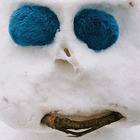
Washington DC Where Magazine (January 2006)
Parting Shot: Freeze Frames
By Jean Lawlor Cohen
Susan Eder calls herself “a conceptual artist who uses photography,” not “a photographer.” She and her collaborator/husband Craig Dennis, in what seems a parody of scientific research, choose to document mundane, non-art things like clouds, exquisitely lit banana slices and popped corn. They know that viewers, confronted by objects in series, tend to “read in” personalities and perceive human faces.
For Snowmen, an edition of 19 chromogenic prints, Eder set out with her camera across wintry landscapes of Virginia’s Fairfax and Arlington counties. “Every eight-year-old makes a snowman,” she says. “Snow must have been used for the earliest effigies.” She knocked on doors and asked permission to shoot each icy figure (from a sports fan in shades, above, to a Goth), all marked by ingenuity — a hot dog nose, Oreo cookie eyes. Just in case some sculptor might later cry foul, Eder talked to art lawyers. “They felt I was O.K. It seems ice sculpture can’t be copyrighted, because it melts.” She’s delighted that Marsha Mateyka Gallery (page 20) recently sold three snowmen images to the State Department for the U.S. embassy in Uzbekistan. “It’s a country in political turmoil. My snowmen may bring smiles to their faces.”
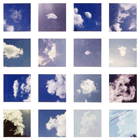
Hyle — International Journal for Philosophy of Chemistry (Volume 9, No. 1, 2003, pp. 105-118)
Four Ways of Measuring the Distance Between Alchemy and Contemporary Art
By James Elkins
...The same, I want to suggest, happens in contemporary art, although the language of alchemical emblems has yet to be applied to it. I choose an example from photography, ... Susan Eder’s collection of photographs called Cloud Faces (Figure 2). Eder is a versatile photographer whose work can be traced most clearly to the institution of the Wunderkammer (roughly: the world as a source of wonder, rather than a repository of science), which is currently undergoing an intermittent renascence in visual art. But the deeper current here, the one that underwrites even the inconsistent revivals of the Wunderkammer, is the tradition of emblems without texts. Here there is no inscriptio or subscriptio, as in La Perrière, and not even any accompanying mystifying text, as in Maier (although gallerists supply such texts with exhibition catalogues). The clouds are simply clouds, or simply faces: there is no clear meaning, no moral, no purpose. There is a bit of whimsy, in this case, and a touch of wonder and playfulness: but to what end? If it had a clear purpose, a La Perrière-style moral, it would probably not be counted as art. I could have chosen pictures with more formal affinity to the seventeenth-century emblems — Clemente’s and Schnabel’s paintings often mix odd symbols with figures — but that would be a little misleading. It’s not the formal similarities that provide the deepest affinities, but the suspension of clear meaning....
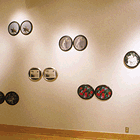
Art Papers Magazine (July/August 2002)
Review: Sights/Seers at the Cultural Arts Center at Glen Allen, VA
By Eileen Mott (excerpt; full text on request)
...Eder’s unwavering stance before the human face speaks of her long journey as a visual archaeologist. She sees the camera as a tool to craft works of inquiry and revelation. Photographs are merely Eder’s starting point, and one of her great strengths is her ability to unearth small truths and from them create artworks that are startlingly beautiful and loaded with painstaking perceptions.
...The most poignant works in the Frames of Reference series are a trio of paired frames entitled “Me Through My Father’s, Mother’s and Husband’s Glasses.” These photographs present six versions of the artist’s face, through the lenses of three people who love her. The resulting distortions are uncanny. Through her father’s glasses, she appears as both angel and imp; through her mother’s, she is younger, rounder, and blurred just enough to be unknowable.
It is through her husband’s lenses that the artist appears most real, closest to what I know Eder to look like. But herein lies the irony and seduction of Susan Eder’s work: I write about photographs made with camera and eyeglass lenses where the subject itself is a photographic self-portrait of the artist — and I reflect upon “what I know Eder to look like” — and I am wearing glasses. This is Eder’s strength: from simplicity she creates conundrum. She shows us truth and, like Emily Dickenson, shows its slant....
Sights/Seers, Two Photographic Points of View: Susan Eder and Chiles T. A. Larson
January 12 - March 2, 2002, Cultural Arts Center at Glen Allen, VA
Brochure essay by curator Deborah McLeod
(excerpt: full text on request)
One photographer is interested in documenting what, where, and especially when we see, as we contemplate the world around us; the other is more curious about how we see. And exactly who sees what. These are very different approaches, and yet each is concerned with the personal landscape of the camera lens and its solemn pledge to tell a truth. But photography is a cosmic trompe l’oeil, a trick of the eye, even when it is behaving as anticipated.
...Take Susan Eder’s two series of photographs, which consider the view from both sides of the spectacle. In Frames of Reference there is the landscape itself: a garden statue, a lily pond, a balloon rally, the family dog, the sister, the brother-in-law. Regular stuff in round frames? Not quite. Eder is only partially concerned with documenting the subject matter she offers the viewer. What she is really after is the condition of human sight and the impossibility of objectivity. Each pair of views is shot directly through the left and right prescription lenses of friends or family members, and playfully framed like eyeglasses. The astigmatisms and degree of visual impairment that come across through this photographic device reveal the perspective of an individually empirical experience, with blurs and distortions decipherable only to that person....
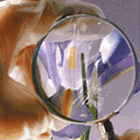
Contemplating the Obvious: Photographic Studies by Susan Eder
September 23 – November 6, 1999, McLean Project for the Arts, McLean, VA
Brochure essay by Martha McWilliams
(excerpt; full text on request)
For those who doubt that we create "reality," Susan Eder’s photographs are a salutary corrective. Her vivid and disturbing works disguise their challenges to certainty in such complex visceral and visual juxtapositions, however, that thoughtful viewers soon long for the relatively tranquil shores of simple paradox. But Eder’s work is never simple, although it often appears straightforward. And while she seems to be looking carefully at objects, images and creatures any citizen might encounter, her gaze is not merely the trained eye of the artist, but more like the paralyzing stare of the basilisk.
Eder’s art is all the more insinuating because of its cheerfully ordinary subject matter and the reassuringly bright colors of her images. A conceptual artist who works with photography, Eder keeps a tight control of both her work’s apparent subjects and her medium. This confidence makes her pictures seem reassuring; but they tend to become transparent, or at least translucent (if an idea can be said to be translucent) to the uncertainty that underpins "everyday life." ...
What most links the artist and the scientist in Eder’s work is the practice of focused looking. But whereas we now doubt the observations of science because observation alters the phenomenon observed, the artist, and certainly Susan Eder, continue to convince us that what we used to call esthetic contemplation can reveal the truth....
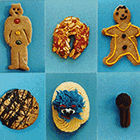
Washington City Paper (Vol. 11 No. 5, Feb. 1-7, 1991)
Susan Eder and John McIntosh at Jones Troyer Fitzpatrick Gallery
By Alice Thorson (excerpt; full text on request)
Where much recent photographic activity has been devoted to exposing how photographs lie, Washington artist Susan Eder employs photography to reveal certain truths. Less a documentarist than a kind of freewheeling social philosopher with a camera, Eder utilizes photography to illustrate and examine the economic values assigned to objects from everyday life....
Many of Eder’s new works comprise pyramidal arrangements of individual photographs. Each piece compiles an assortment of examples of a particular category of object — flowers, zoo animals, bread, dogs, tropical fish — stacked so as to reflect the ascending monetary worth attached to different varieties.... [This] contains a tacit critique of commodity culture, in which value is often assigned in accordance with artificial considerations of fashion and relative scarcity, and the possession of "scarce" objects confers status. That viewers are inevitably drawn to test their own tastes and financial reach — in pets, cookies, etc. — against the hierarchies of work represented here encourages a level of personal involvement....
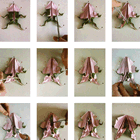
Artforum (November 1982)
Susan Eder, Siegel Contemporary Art and Marian Goodman Gallery
By Charles Hagen
In many of her earlier photographic works, Susan Eder plays one system of meaning off against another. This tactic has been familiar in art since Duchamp’s Ready-mades, in which the formal qualities of common objects are ironically contrasted with their mundane functions. Eder’s pieces too are humorous and heady.
...Eder treats natural phenomena — clouds, leaves — according to various systems of analysis and ordering. In each piece of her “Ghost Images” series of 1976-79, for example, she juxtaposes two postage-stamp-size color photographs, one of an animal, bird or fish, and the other of a cloud having exactly the same shape. At first it may seem that Eder is attempting to deflate the romantic metaphors layered onto natural phenomena. Where Alfred Stieglitz tried to find “Equivalents” for ineffable emotions in clouds, Eder pins them down with abstract logical systems. But in fact her comparisons cut both ways. Not only assumptions about nature, but notions of representation and signification in general — the other element in Eder’s juxtapositions — are challenged as arbitrary. In fact Eder remains if anything a closet romantic, championing the poetic logic of “nature” against the culturally determined logic of sign systems.
[Other] work deals with two more unexpected ordering systems: origami and knots. Both involve the structural transformation of basic geometrical elements. In Origami Frog Dissection, 1982, her frog is folded out of paper that’s gray on one side and pink on the other; as she slices into the object, folding back the flaps of its belly, it turns out that its skin is the gray side of the sheet while its insides are pink....
...In a final group Eder juxtaposes before-and-after photographs of objects that she slices through to form cross-sections. Some of the objects are variations of those in her other work — a blue origami bird, a knot in a gold-sheathed cord or in a rep tie — while some are new: a pink hyacinth, a small cactus. The resulting sectional views have none of the pristine clarity of draftmen’s abstracted renderings; they’re photographs, not drawings. And so they tell more about the desire to understand structure than about the specific structures being considered.
©2009 Susan Eder. All rights reserved. The content of this site, including all text and images, may be used only for purposes of news reporting, comment or research, and it must be credited and attributed to Susan Eder. It may not be used for commercial purposes, and may not be altered, transformed or built upon. Violators will be prosecuted.